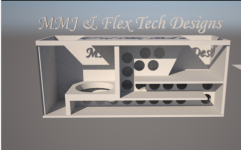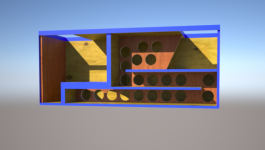For certain! =D
Thanks Johannes! ,
,
Right!
Speaking of optimization: Mr Vansickle finished the cabinet just in time to throw it into the back of his Jeep and head off to the competition so there wasn't much optimization to speak of ...... The cabinet's mouths were facing straight up when he had the measurement taken ....... The following day (Monday) he discovered that if he lays the cabinet down horizontally with mouths facing forward there is what he believes to be a noticeable increase in volume at his listening position (driver's seat) ....... If the difference was noticeable then it might very well translate to a few more measured decibels! We shall see i suppose
We shall see i suppose 
There is another 8th Order Super Planar being built right now by our friend Mario .... It will host a high excursion 15" driver with strong motor made by a company called American Bass .. .... Mario should be finished with his cabinet by the weekend ...... Soon (maybe later this morning) I will post some of Dustin's 3D sketches that he made for Mario unless Dustin beats me to it!! ..
..
It takes time to optimize the whole setup for very high spl.
Very impressive performance!!! More pictures please!!!
Cheers,
Johannes
Thanks Johannes!
 ,
,Right!
Speaking of optimization: Mr Vansickle finished the cabinet just in time to throw it into the back of his Jeep and head off to the competition so there wasn't much optimization to speak of ...... The cabinet's mouths were facing straight up when he had the measurement taken ....... The following day (Monday) he discovered that if he lays the cabinet down horizontally with mouths facing forward there is what he believes to be a noticeable increase in volume at his listening position (driver's seat) ....... If the difference was noticeable then it might very well translate to a few more measured decibels!
There is another 8th Order Super Planar being built right now by our friend Mario .... It will host a high excursion 15" driver with strong motor made by a company called American Bass .. .... Mario should be finished with his cabinet by the weekend ...... Soon (maybe later this morning) I will post some of Dustin's 3D sketches that he made for Mario unless Dustin beats me to it!!
Last edited:
It makes no sense to my why you would do a 'split path' enclosure. Makes it bigger and heavier and need more wood
For car audio drivers with very heavy and strong cones it would not make much difference with single path or split path.
Pro audio drivers generally have larger, lighter and weaker cones as they are optimized for high efficiency. I prefer a symmetrical split path design for pro audio to ease the stresses as much as possible. There is tremendous amounts of pressure on the cone in a tapped horn or quarter wave pipes. If you don't feel confident standing slightly off center on the cone of your chosen driver then you might need to consider split path designs.
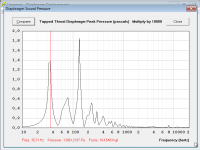
Here is the simuĺated tapped horn throat pressure on the cone of a PD.1851/2 with 4000 watts and 12 mm xmax in a ROAR18.
You totally get it, although it might be more than just a burp machine =D
Just A Guy,
Thank you Sir! and you nailed most of the above ..
The driver is rated with 16mm one-way Xmax .... Though not expensive as it looks , it comes from a company called "Resilient Sounds" which Mr Vansickle says is fairly new and was selling this 8" for a surprisingly reasonable price ..
Yes , he is using a 1000-ish watt class D amp . .
and yes, he figures his cabin gain is centered around 60hz .... His vehicle is a Jeep, i cannot remember which model, i can ask .....
We wanted something that could "burp" some substantial numbers but were hoping that it could also sound musical all at the same time ..... It doesn't have much low-end extension but he says it does sound good playing standard music with the 40hz subsonic filter switched off.... It is listenable he says, Musical ......
When he was using it in the competition he chose to engage the high pass filter just to be safe ...
The cabinet was designed with the upper resonances placed around 80hz and 100hz which should hopefully extend the response out to at least 100hz with authority , and according to simulation it might carry out as far as 150hz (but the manufacturer of the driver did not disclose the voicecoil inductance so it is hard to say if the simulation was optimistic on the upper end of the passband or not) ........... Mr V said he was going to attempt to get a response measurement ........ If the cabinet is as musical as he says it is then there is a good chance that this isn't just a one-note-wonderbox A response measurement to verify that would be great
A response measurement to verify that would be great 
high excursion driver, looks like maybe 20 mm usable excursion.
You've got a 1000 watt (or more) amp.
Neither the driver nor the amp need to sustain high power for more than a couple of seconds, so they can both provide absurd burst power.
You've got a 50 hz tuning.
You've got a HUGE and very complex enclosure. 140 liters for an 8 inch driver with a 50 hz tuning? That's big. And it's a high order enclosure.
And you've got a measured cabin gain that maxes out around the enclosure tuning frequency. And since this guy is a spl competitor he probably chose a vehicle that has abundant cabin gain at a high(ish) frequency.
These results are not unexpected, it's simply good design.
This is a burp machine, pretty much useless for anything else. Everything is tuned high and very particularly to work together as a system, taking full advantage of the car's resonant frequency. This is an example of good design to meet a set of goals but it's nothing to get too excited about.
Just A Guy,
Thank you Sir! and you nailed most of the above ..
The driver is rated with 16mm one-way Xmax .... Though not expensive as it looks , it comes from a company called "Resilient Sounds" which Mr Vansickle says is fairly new and was selling this 8" for a surprisingly reasonable price ..
Yes , he is using a 1000-ish watt class D amp . .
and yes, he figures his cabin gain is centered around 60hz .... His vehicle is a Jeep, i cannot remember which model, i can ask .....
We wanted something that could "burp" some substantial numbers but were hoping that it could also sound musical all at the same time ..... It doesn't have much low-end extension but he says it does sound good playing standard music with the 40hz subsonic filter switched off.... It is listenable he says, Musical ......
When he was using it in the competition he chose to engage the high pass filter just to be safe ...
The cabinet was designed with the upper resonances placed around 80hz and 100hz which should hopefully extend the response out to at least 100hz with authority , and according to simulation it might carry out as far as 150hz (but the manufacturer of the driver did not disclose the voicecoil inductance so it is hard to say if the simulation was optimistic on the upper end of the passband or not) ........... Mr V said he was going to attempt to get a response measurement ........ If the cabinet is as musical as he says it is then there is a good chance that this isn't just a one-note-wonderbox
Mr Vansickle finished the cabinet just in time to throw it into the back of his Jeep and head off to the competition
I got that impression, and thats why I posted my 150dB hunch I got while playing with your design in Hornresp.
144 dB from a single 8 inch driver is very impressive, and even more so with no to very little time to properly tune and adjust your setup for maximum performance.
There is some strange things happening once you get the spl up above 140 dB in the front resonators, I guess you need Comsol to properly simulate that behavior though.
Regards,
Johannes
You said it
Well Said Samuel!
A moderate amount of skepticism is needed to keep us grounded, and i think we are doing a decent job here in that regard ..... There is a good balance so far with the discussion of these Super Planar concepts ....
Hornresp is some very solid software and now that we are having some of these cabinets built by a few different people we will now get to learn about how well the real-world results correlate with the software models .....
Samuel, i will post some more data here for you very soon I had to adjust our model by a small amount in order to make everything fit into the 24" x 54" x 36" outer dimensions, but it works!
I had to adjust our model by a small amount in order to make everything fit into the 24" x 54" x 36" outer dimensions, but it works!
I do have a question though Samuel:
What sort of "tops" did you plan on using with these 8th order subs? and at what frequency would you prefer to cross over to your tops?
I can see that some are skeptical and some are over-critical of the 8th Order Super-Planar approach. It is good, if it is regulated by scientific temper.
However, let us not derail progress. Thanks.
Well Said Samuel!
A moderate amount of skepticism is needed to keep us grounded, and i think we are doing a decent job here in that regard ..... There is a good balance so far with the discussion of these Super Planar concepts ....
Hornresp is some very solid software and now that we are having some of these cabinets built by a few different people we will now get to learn about how well the real-world results correlate with the software models .....
Samuel, i will post some more data here for you very soon
I do have a question though Samuel:
What sort of "tops" did you plan on using with these 8th order subs? and at what frequency would you prefer to cross over to your tops?
Re - split-path
It seems that way !
Anyway, continued success with your designs, & to the people who build & test & post, All the best with them
Originally Posted by Matthew Morgan J
So you could say there are pros and cons ...
It seems that way !
Anyway, continued success with your designs, & to the people who build & test & post, All the best with them
Here is the simuĺated tapped horn throat pressure on the cone of a PD.1851/2 with 4000 watts and 12 mm xmax in a ROAR18.
I think you did something wrong here. I simmed the &C 18SW115 at xmax in the Roar18 and it reaches 14,5mm xmax at 1200wats. Diagram pressure is about 102kg.
Just to make sure I also sim'd the pd1851/2 and it reached xmax of 12mm at 900w giving diagram pressure of 93kg. Or the Roar18 hornresp data I have is complete wrong or your measurement is compet faulty.
For the giggles I put in 4000w and see what happend....not 12mm but 26mm xmax. The PD cone is probably destroyed way before that...
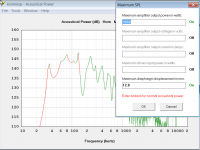
First I simulate the PD.1851/2 in a ROAR18 in 1.0 Pi radiation angle.
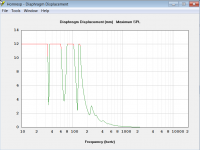
The I go to the driver displacement window
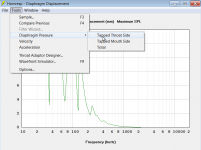
And there is the diaphragm pressure tapped horn throat side.
I simmed the &C 18SW115 at xmax in the Roar18 and it reaches 14,5mm xmax at 1200wats. Diagram pressure is about 102kg.
I might have done something wrong, but even your 102 kg pressure is a quite substantial stress on 200 grams of thin fiber reinforced paper.
You would not see these kinds of loads in real life, or we would all have to vacuum clean out the dust that previously was the cone. In real life the plywood will flex, the cone will flex and there are other losses. It does show the importance of using a limiter in live sound use. A total cone failure is only a dropped microphone away if you are using powerful multi-kw amp without the right processing and limiters.
Some information that i hope you will find useful =)
USRFobiwan,
PA subwoofer duty or Car Audio, either way, so far it seems that these cabinets will be useful in a variety of applications ... . The B&C 18SW115 is most definitely a good choice and if those other drivers have similar motor force figures (BL^2/Re) then they could work as well, but if you would want to go with one of those other choices then we should plug the parameters into our Hornresp model to verify and possibly adjust the model to optimize for the particular driver ....
... . The B&C 18SW115 is most definitely a good choice and if those other drivers have similar motor force figures (BL^2/Re) then they could work as well, but if you would want to go with one of those other choices then we should plug the parameters into our Hornresp model to verify and possibly adjust the model to optimize for the particular driver ....
Referring to your modified sketch you should make the cabinet 36" deep while giving the two larger resonator chambers about 2800cm sq CSA each ...... If you plan on loading this cabinet with the 18SW115 then the slender part of the main path needs to have 1000cm sq CSA at 190cm length .... 24" cabinet height works out about right but it is all somewhat flexible as long as the CSAs calculate out properly and the resonators have sufficient depth/length.. ..
If you wanted to increase performance further you could inflate the CSA on the large resonators to something like 3000cm sq or even 3200cm sq if you really wanted to, however at this point the cabinet is getting VERY LARGE .......
These are BIG cabinets , but the output is also BIG
USRFobiwan, to help answer your question about symmetrical split-path versus a traditional single path there will probably be no significant difference in efficiency with either option, but there is this concern about cone loading and driver lifespan that Johannes brings up ...
NOTE:
Whether split-path or not the compression ratio here is barely more than 1:1 in this case, so our design should (in theory) be considerably more cone-friendly than the high compression ratio FLH designs and high compression ratio Tapped Horn designs .... The split-path option could potentially make it even more cone-friendly at the cost of a little more weight, size and material ..
Are we talking about the Car audio or PA type of audio cabinet? It is a bit confusing for me now. Since my modified image was for the B&C 8th order design. It makes no sense to my why you would do a 'split path' enclosure. Makes it bigger and heavier and need more wood. Unless the split path design makes a real big difference in output (like +4db and more) I see no point in doing this.
I have a couple of drivers laying around for test use. B&C 18SW115, Oberon 18XB1500, 18Sound 18NLW9601 and a Beyma 18LEX1600Nd.
USRFobiwan,
PA subwoofer duty or Car Audio, either way, so far it seems that these cabinets will be useful in a variety of applications
Referring to your modified sketch you should make the cabinet 36" deep while giving the two larger resonator chambers about 2800cm sq CSA each ...... If you plan on loading this cabinet with the 18SW115 then the slender part of the main path needs to have 1000cm sq CSA at 190cm length .... 24" cabinet height works out about right but it is all somewhat flexible as long as the CSAs calculate out properly and the resonators have sufficient depth/length.. ..
If you wanted to increase performance further you could inflate the CSA on the large resonators to something like 3000cm sq or even 3200cm sq if you really wanted to, however at this point the cabinet is getting VERY LARGE .......
These are BIG cabinets , but the output is also BIG
USRFobiwan, to help answer your question about symmetrical split-path versus a traditional single path there will probably be no significant difference in efficiency with either option, but there is this concern about cone loading and driver lifespan that Johannes brings up ...
NOTE:
Whether split-path or not the compression ratio here is barely more than 1:1 in this case, so our design should (in theory) be considerably more cone-friendly than the high compression ratio FLH designs and high compression ratio Tapped Horn designs .... The split-path option could potentially make it even more cone-friendly at the cost of a little more weight, size and material ..
Last edited:
Thanx MMJ, Yes drivers have the same same bl values around 30/31 BL and suitable for horn-loading, except the beyma which is a more bassreflex oriented driver. I will mockup some designs and see if i can prototype the coming winter months.
@Circloman, seems your not wrong but taking a different approach to get the diagram pressure. I fill in the 'Eg' part of the input parameters screen and add voltage until I reach the xmax of the driver in the displacement window and then check the pressure.
@Circloman, seems your not wrong but taking a different approach to get the diagram pressure. I fill in the 'Eg' part of the input parameters screen and add voltage until I reach the xmax of the driver in the displacement window and then check the pressure.
The driver is rated with 16mm one-way Xmax ....
As expected. Did you account for lossy inductance in the sim? Lossy inductance will present as about 1/3 less motor strength than the t/s suggest unless you account for it. That changes thing a lot. You'll get a totally different frequency response and behavior than the sim predicts.
and yes, he figures his cabin gain is centered around 60hz .... His vehicle is a Jeep, i cannot remember which model, i can ask .....
Yeah, a huge high order box tuned to 50 hz with cabin gain peaking at 60 hz is going to get loud. A simple undersized ported box tuned around 50 hz would probably give the same burp spl though - the undersized ported box will peak about 10 db at the frequency you design it to. This is how Kicker wins comps even though the drivers are mediocre at best, high tuning with a massive peak in response.
We wanted something that could "burp" some substantial numbers but were hoping that it could also sound musical all at the same time ..... It doesn't have much low-end extension but he says it does sound good playing standard music with the 40hz subsonic filter switched off.... It is listenable he says, Musical ......
Listenable I believe. Musical, not so much. With the 50 hz tuning and a very steep rolloff below tuning (even if not using a high pass) you won't have much bass at all below 50 hz. The cabin gain won't be nearly enough to flatten that out even when not using a high pass filter.
Also I've not looked at your sims but if yours have the big dip at the top of the passband like the ROAR series it's impossible to get good crossover integration.
If the cabinet is as musical as he says it is then there is a good chance that this isn't just a one-note-wonderboxA response measurement to verify that would be great

Like I said, regardless of how smooth it is through the passband, the passband only goes down to 50 hz. You can play games with not using a high pass filter and even boosting below tuning to flatten it out but none of this is a good idea. It will amount to high distortion at moderate spl and a damaged driver if he isn't really careful.
It would seem to be adequate and well designed for what it is but what it is is a burp machine, not a daily driver sub.
If it behaves anything like our ROAR-series, then it should be very easy to integrate into a complete system and it should sound very nice with a much deeper perceived bass response then the 50 Hz tuning would suggest. My ROAR12 is tuned to 45 Hz but I seldom find it lacking when playing EDM, Reggae and dubstep indoors in my livingroom. when used outside it might be a little "thin" when playing dubstep or very bass heavy EDM.
It should be a very exiting experience to sit in the car when the 8 inch driver is fed 1000 watts.
I believe your 8th order Super Planar bass box should be very easy to cross over to a top system. Even more so then the ROAR. The deep suckout above passband is much better then the rapid phase changes and large peaks in group delay you see in a normal tapped horn design.
The era of normal tapped horns is coming to an end in many ways. Tom Danley seems to focus on other solutions as well.
It is fun to explore the first real large improvement in bass reproduction since Tom Danley created his TH115. Most of the designs since then has only been small incremental improvements based on better drivers.
Lately the drivers have become "to powerful" for normal tapped horns (IPAL and similar drivers).
Thanks for your continuing effort to explore and develop this idea and share your results with very contagious enthusiasm.
It is people like you Matthew Morgan J that makes this forum a fun place to visit.
Regards,
Johannes
It should be a very exiting experience to sit in the car when the 8 inch driver is fed 1000 watts.
I believe your 8th order Super Planar bass box should be very easy to cross over to a top system. Even more so then the ROAR. The deep suckout above passband is much better then the rapid phase changes and large peaks in group delay you see in a normal tapped horn design.
The era of normal tapped horns is coming to an end in many ways. Tom Danley seems to focus on other solutions as well.
It is fun to explore the first real large improvement in bass reproduction since Tom Danley created his TH115. Most of the designs since then has only been small incremental improvements based on better drivers.
Lately the drivers have become "to powerful" for normal tapped horns (IPAL and similar drivers).
Thanks for your continuing effort to explore and develop this idea and share your results with very contagious enthusiasm.
It is people like you Matthew Morgan J that makes this forum a fun place to visit.
Regards,
Johannes
If it behaves anything like our ROAR-series, then it should be very easy to integrate into a complete system
Forgive me if I don't take your word for it. I've spent some time playing with crossovers and a massive steep and wide 22 db dip at the top of the passband assures there's no possible way to get good integration through the crossover. This is science, not your subjective feelings. Can you make it work? Sure, but not well.
... and it should sound very nice with a much deeper perceived bass response then the 50 Hz tuning would suggest. My ROAR12 is tuned to 45 Hz but I seldom find it lacking when playing EDM, Reggae and dubstep indoors in my livingroom. when used outside it might be a little "thin" when playing dubstep or very bass heavy EDM.
Yeah right, and when you turn the high pass filter off it's just too powerful and makes everyone sick, right? And it's a great home theater sub even with it's 45 hz tuning. This is what you stated previously.
Your subjective feelings in the complete absence of measurements to back you up makes it sound like you don't have much experience with speakers at all. Either that or the pride of your own design has completely blinded you to reality. A 45 hz tuning is going to make for a sub that is not in any way adequate for modern music, much less make anyone sick.
I believe your 8th order Super Planar bass box should be very easy to cross over to a top system. Even more so then the ROAR. The deep suckout above passband is much better then the rapid phase changes and large peaks in group delay you see in a normal tapped horn design.
The deep suckout at the top of the passband ruins an otherwise workable design. There's no huge phase changes or group delay in a good tapped horn design. Phase more or less follows frequency response, if your frequency response is ruler flat your phase is ruler flat. If your frequency response is flat(ish), as in not changing wildly your phase will also be flat(ish).
Here's my tapped horn, built in 2009, 6 inch driver, some stuffing in the throat and mouth, no smoothing in the measurement and measured outside at a distance of close to 10 meters.. Where's the wild frequency response that would lead to wild phase changes and group delay? I don't see it.
An externally hosted image should be here but it was not working when we last tested it.
I've got a big dip in response too, but it's not very wide and well over an octave above the passband. Still, if I were to build today I would get rid of that dip. But that's not the point here, the point is that the frequency response is well controlled, so then will be the phase and group delay. This will be easy to cross over to mains, although obviously textbook filters won't get you there.
The era of normal tapped horns is coming to an end in many ways. Tom Danley seems to focus on other solutions as well.
This is just plain wrong. Tom Danley has a few front loaded horn and exactly one ported box. His wheelhouse has always been front loaded horns so it's not surprising to see a few in the lineup. Tapped horns aren't going anywhere. They aren't as popular as they were when they were first introduced (with all the insane hype surrounding them) but that doesn't mean they are now subpar.
It is fun to explore the first real large improvement in bass reproduction since Tom Danley created his TH115. Most of the designs since then has only been small incremental improvements based on better drivers.
Lately the drivers have become "to powerful" for normal tapped horns (IPAL and similar drivers).
What on earth are you talking about now? This is the kind of hype that got me all up in your face in the first place. Where is this "real large improvement in bass reproduction"? The ROAR? Are you serious?
I showed you I can get the same response as the ROAR from a normal shaped tapped horn. Similar behavior in every aspect except that terrible dip above the passband. How is yours better?
You don't measure anything at all, you can't be serious saying that you are outpacing Danley's work, although it's not a surprise since 2 years ago in the BC218 thread you thought the ROAR WAS the same thing.
Modern drivers absolutely are not too strong for tapped horns. This idea is just plain ridiculous. Check out Ricci's SKHorn for an example of massive power density in a relatively tiny box. It's got 4 of the Rockford drivers in it, those are much more powerful than the Ipal. The SKHorn is not a tapped horn but no matter, the power density in that box is insane.
Nothing you say seems to make any sense at all. The amount of hype you've been spewing around the forum is way over the top and for anyone that understands a bit about how things work, it's completely wrong.
Modern drivers absolutely are not too strong for tapped horns. This idea is just plain ridiculous. Check out Ricci's SKHorn for an example of massive power density in a relatively tiny box. It's got 4 of the Rockford drivers in it, those are much more powerful than the Ipal. The SKHorn is not a tapped horn but no matter, the power density in that box is insane.
Thanks Just a Guy for proving my point.
Regards,
Johannes
The era of normal tapped horns is coming to an end in many ways. Tom Danley seems to focus on other solutions as well.
Like the THMini15 shown at Infocomm this year?
YouTube
Super Planar 8th order design compared to a Bass Reflex "burp" box
A few different people (here and in other forums) had asked about how the Super Planar 8th order cabinet would look compared to a simple Bass Reflex (vented , Helmholtz) tuned with an intentional peak for usage in SPL competitions ....
This is a valid question and I was curious about it myself so i put together this comparison ..... It is fair , as the tuning, driver, and cabinet volume are all the same .... Same 1/8th space environment .... The same RS 8 subwoofer was driven to it's Xmax rating in both cases ....
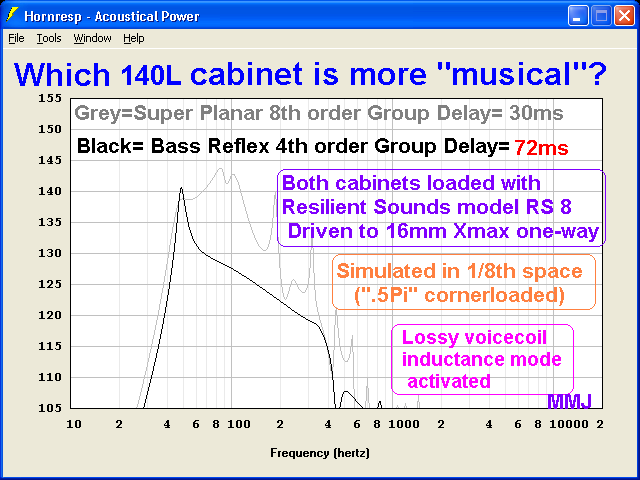
Mr Vansickle says that his Super Planar 8th order cabinet is "musical" and it is easy to see why he might say that (based on the grey curve) .......
A few different people (here and in other forums) had asked about how the Super Planar 8th order cabinet would look compared to a simple Bass Reflex (vented , Helmholtz) tuned with an intentional peak for usage in SPL competitions ....
This is a valid question and I was curious about it myself so i put together this comparison ..... It is fair , as the tuning, driver, and cabinet volume are all the same .... Same 1/8th space environment .... The same RS 8 subwoofer was driven to it's Xmax rating in both cases ....

Mr Vansickle says that his Super Planar 8th order cabinet is "musical" and it is easy to see why he might say that (based on the grey curve) .......
- Home
- Loudspeakers
- Subwoofers
- Compound loading 6th order quarterwave "Super Planar" horns and pipes concepts/builds
